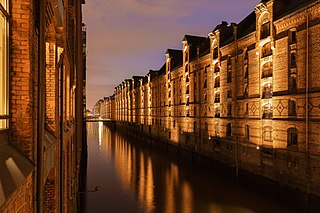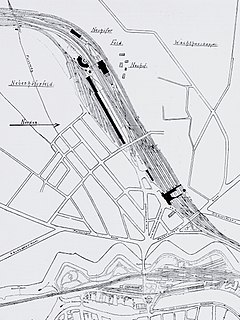
Hamburg, officially the Free and Hanseatic City of Hamburg, is the second-largest city in Germany after Berlin and 7th largest city in the European Union with a population of over 1.84 million. Hamburg's urban area has a population of around 2.5 million and its metropolitan area is home to more than five million people. The city lies on the River Elbe and two of its tributaries, the River Alster and the River Bille. One of Germany's 16 federated states, Hamburg is surrounded by Schleswig-Holstein to the north and Lower Saxony to the south.

St. Pauli is a quarter of the city of Hamburg belonging to the centrally located Hamburg-Mitte borough. Situated on the right bank of the Elbe river, the nearby Landungsbrücken is a northern part of the port of Hamburg. St. Pauli contains a world-famous red light district around the iconic Reeperbahn area. As of 2016 the area had 22,595 residents.

The Port of Hamburg is a seaport on the river Elbe in Hamburg, Germany, 110 kilometres (68 mi) from its mouth on the North Sea.

Hamburg-Altona is a railway station in Hamburg, Germany, situated to the west of the city's main station, in the district which bears its name.

The HHLA Container Terminal Altenwerder (CTA) in Hamburg, Germany currently is one of the most modern container terminals in the world, located in the Altenwerder quarter. It is owned by the Hamburger Hafen und Logistik AG (HHLA) (74.9%) and Hapag-LLoyd AG shipping lines (25.1%) and lies to the south of Hamburg on the river Elbe.

Finkenwerder is a quarter of Hamburg, Germany in the borough Hamburg-Mitte. It is the location of a plant of Airbus and its airport. In 2016 the population was 11,727.
Fishmarket, also spelt Fish Market, is a street in Luxembourg City, in southern Luxembourg, that shares its name with the neighbourhood directly surrounding it. It lies in the eastern part of the Ville Haute quarter.

HafenCity is a quarter in the district of Hamburg-Mitte, Hamburg, Germany, Europe. It is located on the Elbe river island Grasbrook, on the former Port of Hamburg area. It was formally established in 2008 and also includes the historical Speicherstadt area, which since 2015 is an UNESCO World Heritage Site with the adjacent Kontorhausviertel. The main landmark of the HafenCity is the Elbphilharmonie concert hall.

Blankenese is a suburban quarter in the borough of Altona in the western part of Hamburg, Germany; until 1938 it was an independent municipality in Holstein. It is located on the right bank of the Elbe river. With a population of 13,407 as of 2016, today it is widely known as one of Hamburg's most affluent neighborhoods.
The city of Hamburg in Germany is made up of seven boroughs and subdivided into 104 quarters. Most of the quarters were former independent settlements. As of 2008 the areal organisation is regulated by the constitution of Hamburg and several laws.

The Internationales Maritimes Museum Hamburg is a private museum in the HafenCity quarter of Hamburg, Germany. The museum houses Peter Tamm's collection of model ships, construction plans, uniforms, and maritime art, amounting to over 40,000 items and more than one million photographs. It opened in a former warehouse in 2008.
Hamburger Hafen und Logistik AG, known until 2005 as Hamburger Hafen- und Lagerhaus-Aktiengesellschaft, and prior to that as Hamburger Freihafen-Lagerhaus Gesellschaft (HFLG) since 1885, is a German logistics and transportation company specialising in port throughput and container and transport logistics.
Transport in Hamburg comprises an extensive, rail system, subway system, airports and maritime services for the more than 1.8 million inhabitants of the city of Hamburg and 5.3 million people in the Hamburg Metropolitan Region.

The Speicherstadt in Hamburg, Germany is the largest warehouse district in the world where the buildings stand on timber-pile foundations, oak logs, in this particular case. It is located in the port of Hamburg—within the HafenCity quarter—and was built from 1883 to 1927.

The Lübeck-Büchen Railway was a German railway company that built railway lines from Lübeck to Büchen and to Hamburg in the 19th century.

Steinwerder is a quarter of Hamburg, Germany in the borough Hamburg-Mitte on the southern bank of the river Elbe. It is a primarily maritime industrial location, with a resident population in 2016 of only 38.
The following is a timeline of the history of the city of Hamburg, Germany.

BLG Logistics Group AG & Co. KG is a seaport and logistics company with headquarters in Bremen. The operative divisions offer services for automobile, industry and trading customers. The company has more than 100 locations in Europe, North and South America, Asia and Africa.
The accession of the city state of Hamburg to the Customs Union in 1888 was the culmination of a project for the economic and monetary union of Germany, stretching back to 1819. In that year Schwarzburg-Sondershausen joined Prussia’s internal customs union, the first other state to do so and the first of many to follow.














